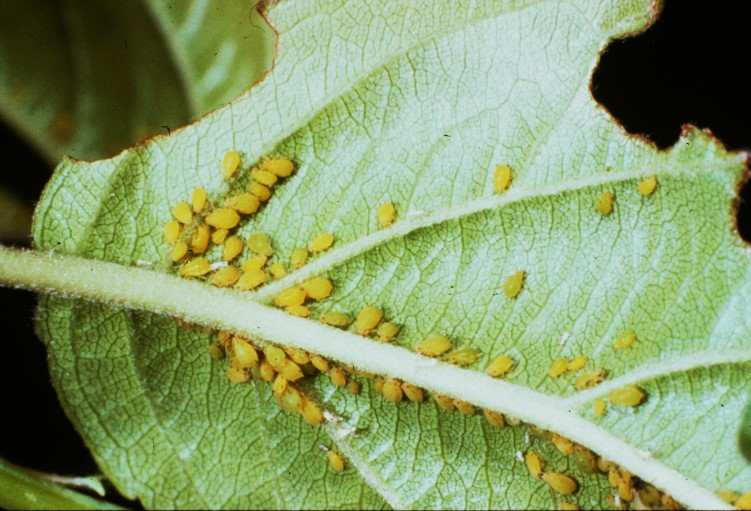Issue 5, June 17, 2021
Aphids
Aphids (Family: Aphidae) are one of the most common insect pests in the home landscape. They have small, pear-shaped bodies that can be many colors, including green, brown and yellow. Aphids can be identified by small structures called cornicles, which look like tailpipes on the rear ends of the insects. Aphids can be winged or wingless, with winged individuals appearing later in the season. Aphids can have many generations in a single year, so it is a good insect to scout for throughout the growing season.
For an in-depth discussion of the complex aphid life cycle, please refer to this previous Home, Yard, and Garden article.


Left: Oleander aphid (Aphis nerii), Joseph Berger, Bugwood.org
Right: Aphids, Phil Nixon, University of Illinois at Urbana-Champaign
There are many species of aphids in Illinois and they feed on a large range of host plants. Aphids suck fluids from stems and leaves while the leaves are still expanding. This can result in discoloration, leaf-curling, misshaped leaves and stem distortion.
Aphids also produce sugary droppings called honeydew. The honeydew coats the leaves giving them a shiny, sticky appearance and supports sooty mold growth. Aphids are primarily controlled to prevent honeydew, rather than their feeding injury.
Injury caused by aphids may be present before gardeners spot the aphids themselves. Inspect the undersides of leaves and the tips of twigs and new leaves to confirm that aphids are causing the injury.
One factor that can complicate aphid control is ants. Some species of ants feed on the sugary honeydew produced by the aphids. This is such an attractive food source that ants sometimes “farm” the aphids and defend them from natural enemies. If you are trying to control an aphid population that is being guarded by ants, you may need to control the ants before you can successfully control the aphids.
Biological Controls:
Aphids have many natural predators including lady beetles, hover flies, lacewings and parasitic wasps. In many cases, aphids may be present, but their populations are controlled by natural enemies and they do not cause significant injury or require treatment. Natural enemies can be encouraged in the landscape by adding flowering plants. Natural enemies can also be released in landscapes or greenhouse areas to increase predator populations and overwhelm the pests.
Cultural Controls:
Aphids may thrive on plants that have received nitrogen fertilizers. Reducing nitrogen fertilization can slow population growth and result in overall smaller populations of aphids.
Mechanical Controls:
For small populations, aphids can be wiped from plants or removed with a blast from a hose. Very localized populations can also be removed by pruning away heavily infested portions of the plant.
Control with Insecticides:
Aphids can be controlled using one of many different insecticide products. Organic options include insecticidal soaps and many oil products. They are also susceptible to many contact insecticides including pyrethroids, chlorantraniliprole (Acelepryn), acephate (Orthene, others) and abamectin (Abacide, others). They can also be controlled with systemic products like imidacloprid (Merit, others), but it is important to apply these treatments only after the plant has completed blooming to avoid exposing pollinators to the treatment.
Author:
Sarah Hughson